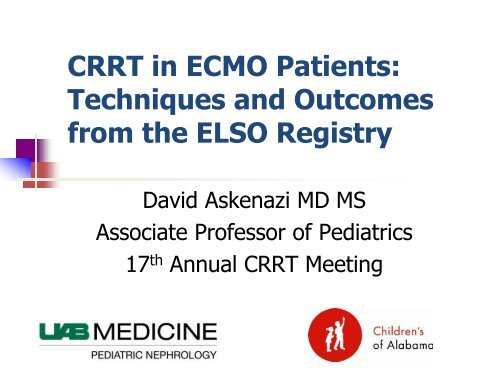CRRT and ECMO Techniques and Outcomes from ... - CRRT Online
CRRT and ECMO Techniques and Outcomes from ... - CRRT Online
CRRT and ECMO Techniques and Outcomes from ... - CRRT Online
Create successful ePaper yourself
Turn your PDF publications into a flip-book with our unique Google optimized e-Paper software.
<strong>CRRT</strong> in <strong>ECMO</strong> Patients:<strong>Techniques</strong> <strong>and</strong> <strong>Outcomes</strong><strong>from</strong> the ELSO RegistryDavid Askenazi MD MSAssociate Professor of Pediatrics17 th Annual <strong>CRRT</strong> Meeting
Objectives• Discuss how RRT is performed in critically illpatients on <strong>ECMO</strong>• Review the incidence <strong>and</strong> outcomes in <strong>ECMO</strong>patients with AKI / RRT.• Assess if AKI <strong>and</strong> RRT provision areindependently associated with mortality
Extracorporeal MembreaneOxygenation (<strong>ECMO</strong>)• Indications for <strong>ECMO</strong>• Severe acute heart or lung failure• Expected mortality risk ≥ 80% despiteoptimal conventional therapy• <strong>ECMO</strong> initiation usually improveshemodynamic statusELSO Registry General Guidelines. April 2009
<strong>ECMO</strong> initiation maypredispose patients to AKI• <strong>ECMO</strong> initiation causes• Increased inflammatory response 1• Hypercoaguable state 2• Hemolysis/ Hemoglobinuria 31. Kurundkar et al. Pediatric Research August 20102. Shapiro A. Seminars in Hematology 19953. Toomasian J. <strong>and</strong> Bartlett R. Perfusion 2011
Not surprising that thesepatients develop AKI
Technical Considerations
How do you do it? Access
<strong>ECMO</strong> <strong>and</strong> RRT System.Adapted <strong>from</strong> Hoover N et al.Intensive Care Medicine, 2008.
<strong>CRRT</strong> machines with <strong>ECMO</strong>• Access Pressure on <strong>CRRT</strong> may be positive• Some Dialysis Machines can allow for alarmsto be adjusted during <strong>ECMO</strong>• Clamps can be used to avoid these alarms• Increases Hemolysis• Circuit prime• Can use either a saline prime or blood prime• Careful with heparin rinse
<strong>ECMO</strong> <strong>and</strong> In-Line Hemofilter System.Adapted <strong>from</strong> Hoover N et al.Intensive Care Medicine, 2008.
<strong>ECMO</strong> <strong>and</strong> In-Line Hemofilter SystemRSCUFCVVH.Adapted <strong>from</strong> Hoover N et al.Intensive Care Medicine, 2008.
<strong>ECMO</strong> <strong>and</strong> In-Line Hemofilter SystemRDCVVHD.Adapted <strong>from</strong> Hoover N et al.Intensive Care Medicine, 2008.
<strong>ECMO</strong> <strong>and</strong> In-Line Hemofilter SystemRDCVVHDF.Adapted <strong>from</strong> Hoover N et al.Intensive Care Medicine, 2008.
<strong>CRRT</strong> on <strong>ECMO</strong> using“Homemade” In-Line system• Must return “dialyzed blood” preBLADDER• IV infusion pumps control ultrafiltrate• Up to 12.5 % inaccuracies in some studies• IV pumps are not engineered to maintainaccuracy at higher pressures
Ultrafiltration Error Rate Increaseswith Increasing Flow/PressureDifferentialSucosky, Paden et al., JMD 2008
What type of modality is usedNO RRTRRT MachineIN- LINEunknownFlemming G, et al.– abstract <strong>CRRT</strong> 2012KIDMO Study Group
Modality with RRT machineSCUF CVVH CVVHD CVVHDFFlemming G, et al.– abstract <strong>CRRT</strong> 2012KIDMO Study Group
Modality w/ In-Line HemofilterSCUF CVVH CVVHD CVVHDFFlemming G, et al.– abstract <strong>CRRT</strong> 2012KIDMO Study Group
Differences between RRT methodsIn Line Hemofilter <strong>CRRT</strong> machineUltrafiltrationcontrolIV pump controlled<strong>CRRT</strong> machinecontrolledMetabolic Control NOT if only using SCUF YES<strong>ECMO</strong> Flow Blood ShuntNO systemic changes-decrease <strong>ECMO</strong> flow-decreased PaO2Complexity Less People More People
Epidemiology of AKIin <strong>ECMO</strong> patients
How often does AKI happen in<strong>ECMO</strong> patients?• Single Center Pediatric Data• Neonates with congenital diaphragmatichernia (CDH) 1 – 84%• Children with Cardiac Indications 2 – 71%1. Gadepalli et al. Pediatric Surgery July 20102. Smith et. al ASAIO 2009
Single Center Adult DataRetrospective analysis of 46 adults on <strong>ECMO</strong> usingRIFLEF24%I39%NO22%R15%78% ofpatientshad AKILin, C.-Y. et al. NDT. 200622
RIFLE in adults on <strong>ECMO</strong>Survival8/10 (80%)3/7 (57%)5/18 (28%)0/11 (0%)Lin, C.-Y. et al. NDT. 2006
Adults on <strong>ECMO</strong> Post-CardiotomyAKI by RIFLE at 48 hrsAKI by AKIN at 48 hrsF36%I28%NO AKI19%R17%348%No AKI15%218%119%81% incidence of AKI 85% incidence of AKIYan X. et al.; Eur J Cardthorac Surg 2010
Adults on <strong>ECMO</strong> Post-CardiotomyAKI by RIFLE at 48 hoursStage F vs. NO AKIIndependent OR for death= 12.6 (95% CI = 2.2–72.3)p = 0.005AKI by AKIN at 48 hoursStage 3 vs NO AKIIndependent OR for Death= 30.8 (95% CI = 3.3–287.2)p = 0.003.Yan X. et al.; Eur J Cardthorac Surg 2010
RRT provision is associatedwith poor survival1009080706050403020100<strong>ECMO</strong> onlyN = 224<strong>ECMO</strong> + <strong>CRRT</strong> N= 154NeonatalPaden et al. PCCM March 2011
RRT provision is associatedwith poor survival1009080706050403020100<strong>ECMO</strong> onlyN = 224<strong>ECMO</strong> + <strong>CRRT</strong> N= 154NeonatalPediatricPaden et al. PCCM March 2011
ELSO Registry 1985- 2008:Pediatric Cardiac Indications6050403020No dialysisDialysis1000-30 days 1-12 months 1-16 years > 16 years28
Association ≠ CausalityAre AKI / RRT independentlyassociated with mortality in <strong>ECMO</strong>patients?
Extracorporeal Life SupportOrganization (ELSO) Registry• ELSO Registry• Composed of nearly all <strong>ECMO</strong> casesworldwide• Over 40,000 cases• 2 separate registries – cadiac <strong>and</strong>noncardiac
ELSO Registry – 1998 - 2008NeonatesN =7941 children
ELSO Registry – 1998 - 2008PediatricsN = 1962 children
ELSO Registry – 1998 - 2008AdultsN = 1011 adults
Variables Analyzed• Outcome – Survival vs. Non-survival• Primary exposures of interest• AKI• Complication code of SCr ≥ 1.5 mg/dl or• ICD-9 code of Acute renal failure• Dialysis• CPT codes usedAskenazi et al. Pediatric Critical Care Medicine 2011
Potential Confounders Analyzed• Demographics• Physiologic Data before <strong>ECMO</strong>• Physiologic Data during <strong>ECMO</strong>• Therapy characteristics• Co-morbid conditions• Complications• InterventionsAskenazi et al. Pediatric CCM 2011
ELSO Registry - Neonates18%5%3%74%NeitherAKIBothRRTAskenazi et al. Pediatric CCM 2011
Pediatric ELSO registry16%4%26%54%NeitherRRTSCr > 1.5 mg/dlBothAskenazi et al. Pediatric Critical Care Medicine 2011
Adult Non-Cardiac ELSORegistryAKI7%Neither51%Both27%RRT15%
10080604020Survival in AKI/ RRT subjects0Neither RRT AKI BothAskenazi et al. Pediatric Critical Care Medicine 2011
10080Survival in AKI/ RRT subjects604020NeonatesChildrenAdults0Neither RRT AKI BothAskenazi et al. Pediatric Critical Care Medicine 2011
Odds of Death for AKI / RRT<strong>from</strong> ELSO RegistryCrude OR Adjusted OR p-valueNeonate AKI 5.8 3.2
AKI / RRT are IndependentlyAssociated with Adult MortalityPropensity Score Matched Case-ControlAcute Kidney InjuryOdds Ratio (95% p-valueCI)Acute Kidney Crude Injury Odds 2.78 Ratio (2.14(95% – 3.60) CI) p < p-value 0.001Propensity Crude score 1.32 2.78 (1.12 (2.14 – 3.60) 1.55) p
Summary• <strong>ECMO</strong> patients can receive RRT on <strong>ECMO</strong>• <strong>CRRT</strong> machine – in series• In-line hemofilter• Watch Ultrafiltration carefully !
Summary• <strong>ECMO</strong> patients can receive RRT on <strong>ECMO</strong>• Acute Kidney Injury is extremely common in<strong>ECMO</strong> patients• Those with AKI <strong>and</strong> those who receive RRThave worse outcomes – independent ofimportant confounders• Improved underst<strong>and</strong>ing of how best tosupport <strong>ECMO</strong> patients with AKI is likely toimprove outcomes















